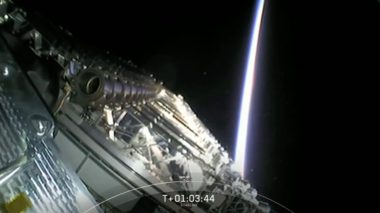News Analysis | SpaceX has a lot riding on Starlink’s $499 “UFO on a stick”
By Brian Berger

Elon Musk’s engineering and business philosophy largely boils down to a three-phase approach: brainstorm it, build it, and test and iterate.
Starlink, his satellite broadband venture, entered the test and iterate phase with the recent opening of its limited public beta.
Musk now needs Starlink to improve and expand across three major areas at once: customer hardware, business models, and the satellite network. It’s a challenge no one in the satellite industry has attempted. What’s more, Musk’s Martian dream of multi-planet humanity may depend upon it.
Starlink’s beta started over the summer in the northern United States. Judging from the early reviews, the beta is going well, with more invitations sent out this fall.
Early customers are paying $499 for Starlink’s required hardware plus $99 per month for a service plan promising 50-150 Mbps of low latency broadband (some users are reporting even faster downloads, which shouldn’t be surprising given the current high ratio of satellites to customers).
To put these metrics in perspective, Musk said during the Starlink brainstorm phase circa 2015 that his low-Earth-orbit broadband constellation would deliver gigabit speeds and that the user equipment would be priced closer to $250.
Even with SpaceX charging double Musk’s early, aspirational price point for the satellite dish and modem, SpaceX is probably losing hundreds of dollars or more every time it ships a Starlink self-install kit to a new subscriber. That’s because Starlink’s “UFO on a stick” antenna is no dumb dish. It’s a self-pointing, phased array antenna capable of maintaining a connection as a succession of Starlink satellites pass overhead.
Earlier this month, Hughes Network Systems President Pradman Kaul suggested during an EchoStar investor’s call that Starlink’s antenna probably costs SpaceX between $1,000 and $1,500 per unit. Analyst Tim Farrar of TMF Associates, told Business Insider he believes the $499 terminal is actually costing SpaceX closer to $1,500 to $2,000 to produce.
If SpaceX is eating such sums for every new customer it acquires, cost reduction becomes a priority as it ramps production to thousands of units per week.
For bandwidth-starved North Americans with disposable income but few if any high-speed options, Starlink shines compared to DSL and barely broadband cable plans pushed by rural telco monopolies with no incentives to upgrade. For rural households interested in lag-free multi-person video conferencing and speed-critical online gaming, Starlink’s low latency also looks pretty good stacked up against the 600-millisecond latencies that burden Hughes’ and Viasat’s geostationary satellite-based services. In the near-term, Starlink can feast on a portion of the 1.5 million HughesNet and Viasat Excede subscribers in North America already paying $100 for a data-capped service that tops out at 50 Mbps downloads.
There’s also a universe of possibilities beyond the direct-to-consumer business model. Starlink’s recent tests with the U.S. Air Force, a three-year trial underway with the Army, and a partnership with Microsoft Azure positions SpaceX’s first satellite venture to provide the Defense Department with cloud power anywhere on the planet. Successful real-world demonstrations supporting firefighting and recovery efforts in the Pacific Northwest only add to Starlink’s government prospects.
Starlink’s next business model iterations will be at least twofold. The easy lift is already occurring — adding overseas coverage in sweet spots where broadband is minimal and consumer pockets are deep, with parts of Australia, Germany, and Japan obvious wins. A reseller model for wireless ISPs and cellular companies, potentially through Google given it was looking to hire a satellite partnership manager, should also emerge at some point to serve areas where $499 up front and $99 per month is out of reach for a typical household.

SpaceX’s biggest challenge is moving from the current satellites to a next-generation constellation. Starlink 2.0 satellites are likely to be bigger, requiring more power to support higher broadband rates, more users per satellite, and optical cross-links to reduce latency and dependence on ground stations. Ramping up with more and larger satellites — be it the 12,000 in SpaceX’s initial FCC filings or 42,000 in later ITU ones — means Starlink is critically dependent upon the rapid iteration of Starship from test hops to operations if SpaceX wants to deploy next-gen Starlink satellites at a faster clip than the 60 at a time Falcon 9 can handle of the current version.
Starlink, like it or not, needs Starship’s lift capability and rapid turnaround between launches to make quick work of putting up tens of thousands of v2.0 and later satellites. And Starship, meanwhile, needs Starlink to generate the billions of dollars SpaceX is counting on to build a large fleet of interplanetary Starships to fulfill Musk’s Mars colonization dream. It’s a big bet, with one project’s iterations feeding the other’s in a virtuous cycle.
Doug Mohney is a reporter and analyst writing about the telecom, IT and satellite industries for over 20 years. He also worked at two internet startups, one which successfully went public.
November 19, 2020 at 11:41PM
via SpaceNews read more...

Post a Comment